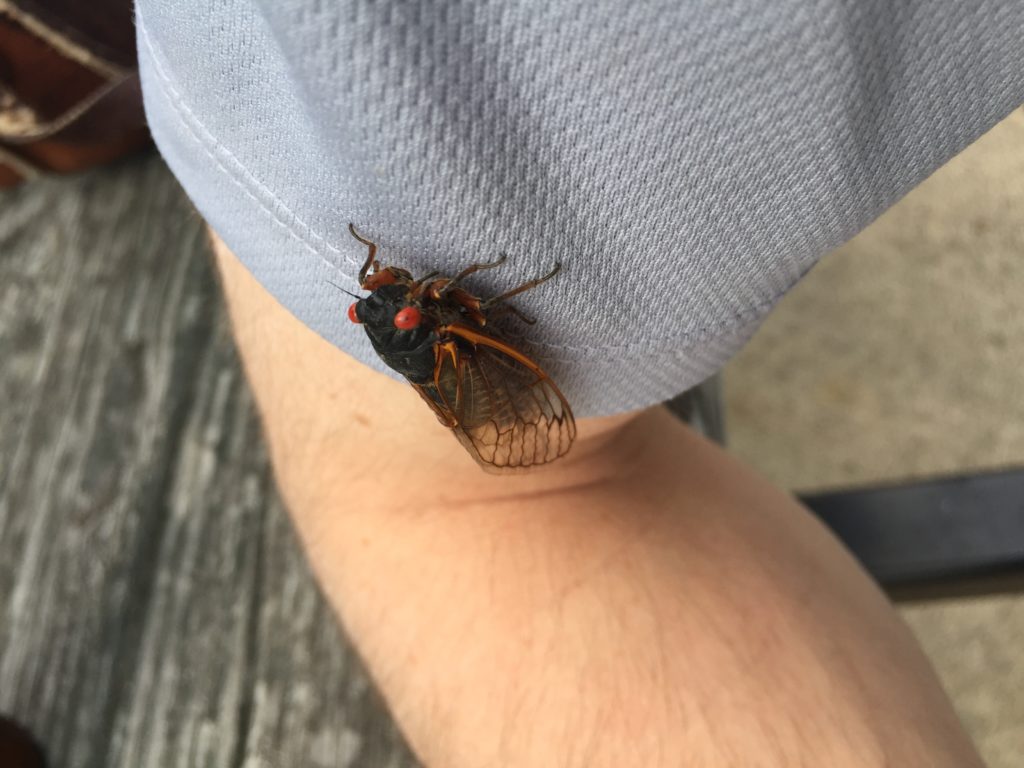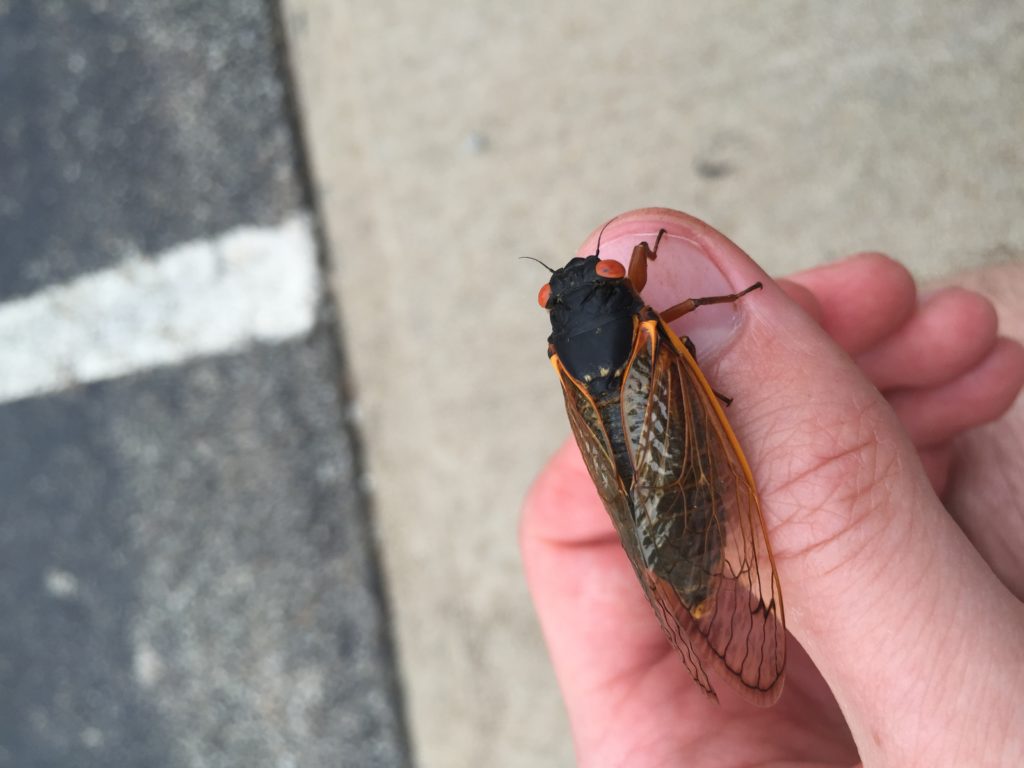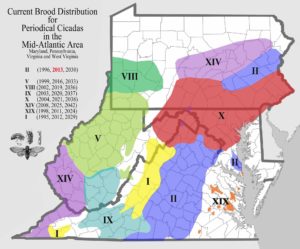17 Year Cicadas
 It was the summer of 1999. I was a 10 year old boy. Looking back now, I couldn’t tell you much of anything that happened in that particular year of my life. I mean, I can’t even tell you what I had for dinner last week. I’m sure I was playing Ocarina of Time and searching for the triforce, and watching 90s cartoons on Nickelodeon on the weekends. But there is one event that I remember so distinctly, so vividly, that it feels it will forever be etched into my memory. My Dad, Mom, sister, and I were heading to our grandparents’ house, as we often did in the summers on the weekends. They have a large yard in a rural area of southwestern Pennsylvania. Something was a bit odd this time, however. There were several small holes poking through the ground. My Dad, quite the outdoors man, made it very apparent that something incredible was about to happen, and to really soak it in.
It was the summer of 1999. I was a 10 year old boy. Looking back now, I couldn’t tell you much of anything that happened in that particular year of my life. I mean, I can’t even tell you what I had for dinner last week. I’m sure I was playing Ocarina of Time and searching for the triforce, and watching 90s cartoons on Nickelodeon on the weekends. But there is one event that I remember so distinctly, so vividly, that it feels it will forever be etched into my memory. My Dad, Mom, sister, and I were heading to our grandparents’ house, as we often did in the summers on the weekends. They have a large yard in a rural area of southwestern Pennsylvania. Something was a bit odd this time, however. There were several small holes poking through the ground. My Dad, quite the outdoors man, made it very apparent that something incredible was about to happen, and to really soak it in.
By the next morning there were more holes…and lots and lots of a particular bug called a cicada. They had hard shells coming out of the ground, and the mature ones were already flying around. Being the 10 year old, outdoor-loving young boy that I was, I quickly became fascinated with them. I sat and watched a few climb on the base of trees and fence posts. They were crawling out of their skin! Goo-looking, yellow and fleshy, I watched one of them harden as it formed its adult body. Ants attacked another one while it was vulnerable. A life lost, but in the grand scheme of things, it didn’t matter, for there were hundreds more. Thousands even. They were EVERYWHERE. You couldn’t take two steps without seeing another one. The ground was crawling. I started to collect some of the leftover shells. I still have a dusty bag of them under my bed, from 17 years ago…
We came back next weekend. All the adults were out in full force. At a nearby grocery store they were all over the place. Soon I had learned to grab them by their wings, and toss them around and watch them fly off. Not the best at flying around…Flying into the building, into cars, and the pavement was littered with them. Their dark bodies and bright red eyes look creepy, but they don’t bite, so it was fun to grab them up and watch them fly. Back at my grandparents, the trees were alive with movement. You could see what almost just seemed like a mass floating around. And the noise! The mating call of the cicada, the constant singing was enough to drown out a normal conversation with someone, it was so loud you could hardly even hear yourself think.
Large Prime Numbers and a biological strategy – Why was it here now?
The cicada is amazing. In the Eastern part of the United States, for 17 long years it waits underground as a nymph, feeding off of tree roots. Then, somehow, it knows…the time has come. Every 17 years, at the right time of year, when the ground warms up enough (around 64 degrees Fahrenheit) they all emerge at once to live their short adult life. After coming out of their shell and molting, the adult flies around for a few weeks looking to mate. The males sing loudly, deafening the air around them. It has been known to reach 100 dB! Females lay their eggs by cutting small slits into tree branches. By mid summer, all the adults are gone, and the eggs soon hatch, burrow underground, and start a new cycle.
 |  |
|---|
 There are two large cycles of cicadas: 17 year and 13 year types, and they have different locations and offsets based on different years of emergence (the one in my area is known as Brood V). But why? Why the large prime numbers? Several biological explanations point to this being a favorable trait. For one, it makes it hard for predators to overwhelm them. Let’s say there is a particular bird that feasts on the cicadas, and it has a life cycle of 4 years, where every 4th year has a larger birth population. This bird and the 17 year cicada will only collide every 68 years! It makes it very difficult for the bird to evolve and synchronize its life cycle with the cicada. Another predator strategy: By an entire population coming out together, it ensures that even if a few do get picked off by birds, there are thousands to replace it. If this was an annual cicada, it could slowly have its population erode from a dominate hunting bird over time. This also means that the similar cicada year types are rarely fighting for the same resources, for only every 221 years will they emerge at the same time! Naturally, there does seem to be some risk to this biological strategy as well. For example, what if there was a large forest fire on the 17th year? A huge chunk of the entire population would be wiped out. Still, the large prime numbers seem to be working for these guys, which means for the 17 year group, you might be luckly to see them 4 or 5 times in your life!
There are two large cycles of cicadas: 17 year and 13 year types, and they have different locations and offsets based on different years of emergence (the one in my area is known as Brood V). But why? Why the large prime numbers? Several biological explanations point to this being a favorable trait. For one, it makes it hard for predators to overwhelm them. Let’s say there is a particular bird that feasts on the cicadas, and it has a life cycle of 4 years, where every 4th year has a larger birth population. This bird and the 17 year cicada will only collide every 68 years! It makes it very difficult for the bird to evolve and synchronize its life cycle with the cicada. Another predator strategy: By an entire population coming out together, it ensures that even if a few do get picked off by birds, there are thousands to replace it. If this was an annual cicada, it could slowly have its population erode from a dominate hunting bird over time. This also means that the similar cicada year types are rarely fighting for the same resources, for only every 221 years will they emerge at the same time! Naturally, there does seem to be some risk to this biological strategy as well. For example, what if there was a large forest fire on the 17th year? A huge chunk of the entire population would be wiped out. Still, the large prime numbers seem to be working for these guys, which means for the 17 year group, you might be luckly to see them 4 or 5 times in your life!
I remember sitting outside of an ice cream and burger place on a hot summer day 17 years ago. The cicadas were singing loudly, and my parents, my sister, and I sat and watched, eating our ice cream, marveling at the nature of this fascinating bug. An old man came up to us, and to my sister and I in particular said, “It’s going to be 17 long years before you see these again!” I think he knew it was probably his last time…
Now, finally, it’s 2016, and they are back. It’s hard to even think about how long 17 years is or what that means, especially when you are 10 years old. This time around, I will certainly reflect on my previous experiences as I have done in this writing, and reflect on how my life has changed over the past 17 years. I will try to once again soak in the memories, watch as these incredible bugs fly around and sing their loud song. My parents want to go to that same ice cream place with my sister and I. It might be their last time, or they might get one more chance at it. 17 years is too long of a time to try and predict, and yet a part of me can’t help but think about the future too…17 years from now, where will I be? Living anywhere even near here? What will my life have become as a middle-aged man? Will I have a family of my own, as I try and explain to them just how special this event in nature is? The truth is that I don’t know. But I do know that the cicada will be there, ready to sing to anyone who wants to listen.

Great piece. You have a easy-reading type of style which is great because the reader can enjoy the entry in a similar way you felt writing it. I never heard of these creatures before this, let alone have knowledge of the rare event. It’s personable, educational, and informational without the feeling of boredom.
Keep it up. I am looking forward to more entries in the future, if you decide to continue.
Rock on brotha.
I always did love your blog posts or pastebins. It was particularly interesting to learn more about the prime numbers and to begin to think about the benefits of these cycles in avoiding predators, but I loved the way that the cicadas can be used to bridge both the past and the future. I hope that, wherever you are in 17 years, you go back and reflect on the summer of 2016, and that your folks are still around to share it with you.